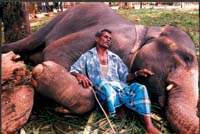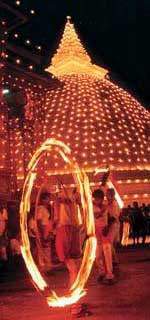| Plus |
|
|||
|
Behind the pageant By Ruwanthi
Herat The hot sun
seems to have had its effect on everyone. In the viharaya compound
everyone seems to be asleep. Close by, the Kelaniya Vidyalaya classrooms
are cluttered with a variety of drums, with drummers, dancers and
others asleep on mats beside them. . Dancing for
Somapala is a profession, only open to family members. Are his sons
dancing in the perahera? "No," is his wistful reply. "But
I mean to get them involved at some point of time. Otherwise our
great traditions will die with me." S. M. B. Sethunge
is the leader of a group of drummers specializing in raban and villakki.
They have been part of the Kelani perahera for 10 years. "I've
been playing the villakki since I was 18, for the past 55 years.
I've got my only son dancing with me even today," Sethunge
who is from Matale explains. However, 'kawadi
natum' is not a family tradition. Sunil Fernando
who works for the Molana Band from Grandpass says, "I had nothing
to do with the perahera when I was young. I worked for the army.
It was only when I retired that I was asked to help out with the
band since I had some experience while in the army." This kawadi
troupe is headed by Sandan Pichchai and 10 members had performed
on Wednesday while 22 were taking part in Thursday's Maha Perahera. There are five
main facets to the Kelani Perahera -- the Udarata Natum, which includes
the ves natum; the Pahatharata Natum such as kolum and devul, the
Sabaragamu dancers, Kawadi and Sinha Natum, the latest addition. The Sinha Natum, similar to South East Asian dances, performed by a group of youngsters from Kataragama, entails the making of a lion's body. Two dancers decked in finery representing this majestic beast slip into this casing and bring the lion to life. Why haven't they kept to the more traditional art forms? "We wanted to do something different. The lion gives immense enjoyment to the children," they say. Meanwhile, in
another corner of the classroom, eight-year-old Rumesh cannot stand
still in his excitement. "This is my first Kelani Perahera,"
smiles Rumesh who has been dancing just under a year. He is a student
of Jinadasa Gamage's 'Kalayathanaya' where anyone with a love of
dancing is free to join. Coming all
the way from Balangoda for this annual pageant K. Punchibandara,
a Sabaragamu dancer is proud of his family tradition. "We have
been a part of this procession for 30 years and will be for a long
time," he says pointing out his sons aged 17 and 13 who have
joined him this year. Back in the
temple grounds, the majestic beasts that warm the hearts of every
perahera viewer are relaxing too, awaiting the evening to get into
their bejewelled costumes. "Abeyta, ada tikkak mahansi,"
(Abey is a little tired today), says Karunaratne, the Basunnahe
from his comfortable bed against a large elephant fast asleep, sprawled
on the grass. 'Abey' is a 15-year-old tusker from the Devundara
Devale, among the 30 elephants sent from different parts of the
country for the Kelani perahera. Each elephant
is allotted two caretakers - the Basunnahe and the Golaya. Shouldn't
the elephant prepare itself for the perahera? "No, all we've
got to do is slip the cloth on him. And it doesn't take much time
at all. The route is embedded in his head anyway," says Karunaratne
proudly. Upali Bandara
who looks after 'Lanka' and 'Hemantha' from the Kotte Raja Maha
Viharaya adds, "These elephants have been participating in
the perahera for the past ten years." |
||||
Copyright © 2001 Wijeya Newspapers
Ltd. All rights reserved. |
 It's all in a day's work for them or rather three nights
work for them come January and Duruthu Poya. But visiting the Kelani
Raja Maha Viharaya one afternoon last week, it is difficult to imagine
a regal and orderly perahera, with arrangements worked out to the
last minute detail and planning taking place from the previous August,
parading the streets of Kelaniya full of pomp and pageantry.
It's all in a day's work for them or rather three nights
work for them come January and Duruthu Poya. But visiting the Kelani
Raja Maha Viharaya one afternoon last week, it is difficult to imagine
a regal and orderly perahera, with arrangements worked out to the
last minute detail and planning taking place from the previous August,
parading the streets of Kelaniya full of pomp and pageantry.